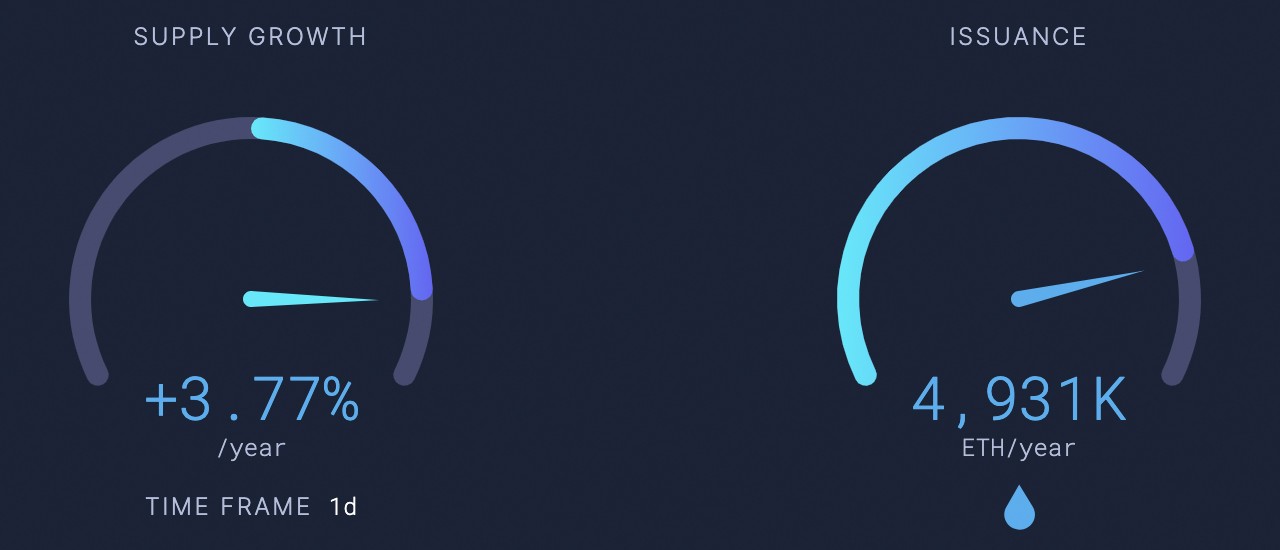‘Ultra Sound Money’ — Post-Merge Stats Show Ethereum’s Issuance Rate Plunged After PoS Transition

Months before Ethereum transitioned from proof-of-work (PoW) to proof-of-stake (PoS), a simulation of The Merge had shown the network’s issuance rate would drop following the ruleset change. Statistics now show that the simulation’s predictions have come to fruition as the network’s issuance rate has slowed significantly since September 15, following the Paris Upgrade that triggered The Merge.
Ethereum’s Issuance Rate Sinks Lower Post-Merge
Since August 5, 2021, Ethereum has changed from being inflationary to deflationary by introducing the ruleset upgrade EIP-1559. Essentially, the change reconfigured the algorithm tied to the base fee per gas in the protocol, and since EIP-1559 was codified, the network now burns the base fee per gas. Since the August 5 London Upgrade, the network has destroyed 2,627,061 ether worth $8.56 billion. Since The Merge, however, Ethereum is a lot more deflationary because the change redefined the protocol’s issuance rate.

Supply growth and issuance statistics if Ethereum was still a PoW chain. Data via ultrasound.money.
For instance, metrics from the web portal ultrasound.money show 3,076 ETH has been issued since The Merge on September 15. If proof-of-work (PoW) miners were still mining ether, they would have produced 53,694 ether since the start of The Merge. The current data shows that Ethereum’s issuance rate post-Merge has dropped by more than 94% lower than if the blockchain would have remained a PoW network. ETH’s deflationary characteristics are believed to be beneficial, as they make ether scarce over time.
4.6 Million Fewer Ethereum by Next Year Thanks to EIP-1559 and Post-Merge Ruleset Changes
Currently, post-Merge data indicates that 297,000 ETH will be burned annually at current rates and issuance has dropped from 3.78% per annum to 0.22% to 0.25% per year. Before The Merge, miners would have produced 4,931,000 ether per year but since the protocol changed to PoS, yearly issuance has slid to 603,000 new ether per year.

Post-Merge statistics show issuance has dropped considerably since the transition. Data via ultrasound.money.
At the time of writing, ETH has a circulating supply of 120,583,249 ether and at current exchange rates the aggregate is worth $158.57 billion in USD value.

Ultrasound.money data shows ETH’s issuance if PoW remained, ETH’s current issuance, and BTC’s 1.72% inflation rate per annum.
This means if Ethereum never Merged, by September 19, 2023, the total supply would be around 125,514,249 without accounting for EIP-1559’s burn rate. With the burn rate and post-Merge rules, ETH’s total supply by September 19, 2023 should be an estimated 120,889,249, or 4,625,000 ether less than it would be under previous PoW consensus rules. Similar to Bitcoin’s halving characteristics, ETH supporters believe the aforementioned ruleset changes will make ether harder than traditional sound money, as proponents these days like to call it ‘ultra sound money.’






 Bitcoin
Bitcoin  Ethereum
Ethereum  Tether
Tether  USDC
USDC  TRON
TRON  Dogecoin
Dogecoin  Cardano
Cardano  Bitcoin Cash
Bitcoin Cash  Chainlink
Chainlink  LEO Token
LEO Token  Stellar
Stellar  Zcash
Zcash  Monero
Monero  Litecoin
Litecoin  Hedera
Hedera  Dai
Dai  Cronos
Cronos  OKB
OKB  Tether Gold
Tether Gold  Ethereum Classic
Ethereum Classic  KuCoin
KuCoin  Gate
Gate  Algorand
Algorand  Cosmos Hub
Cosmos Hub  VeChain
VeChain  Dash
Dash  Tezos
Tezos  Stacks
Stacks  TrueUSD
TrueUSD  IOTA
IOTA  Basic Attention
Basic Attention  Decred
Decred  Theta Network
Theta Network  NEO
NEO  Synthetix
Synthetix  Qtum
Qtum  Ravencoin
Ravencoin  0x Protocol
0x Protocol  DigiByte
DigiByte  Zilliqa
Zilliqa  Nano
Nano  Numeraire
Numeraire  Siacoin
Siacoin  Waves
Waves  Ontology
Ontology  Enjin Coin
Enjin Coin  Status
Status  BUSD
BUSD  Pax Dollar
Pax Dollar  Hive
Hive  Lisk
Lisk  Steem
Steem  Huobi
Huobi  OMG Network
OMG Network  NEM
NEM  Augur
Augur  Bitcoin Gold
Bitcoin Gold  Ren
Ren  Bitcoin Diamond
Bitcoin Diamond